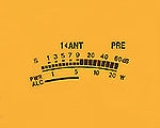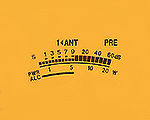
RST code
Encyclopedia

Amateur radio operator
An amateur radio operator is an individual who typically uses equipment at an amateur radio station to engage in two-way personal communications with other similar individuals on radio frequencies assigned to the amateur radio service. Amateur radio operators have been granted an amateur radio...
s, shortwave listener
Shortwave listening
Shortwave listening is the hobby of listening to shortwave radio broadcasts located on frequencies between 1700 kHz and 30 MHz. Listeners range from casual users seeking international news and entertainment programming to hobbyists immersed in the technical aspects of radio reception and DXing...
s, and other radio hobbyists to exchange information about the quality of a radio signal being received. The code is a three digit number, with one digit each for conveying an assessment of the signal's readability, strength, and tone. The code was developed in the early 20th century and was in widespread use by 1912.
Readability
The R stands for "Readability". Readability is a qualitative assessment of how easy or difficult it is to correctly copy the information being sent during the transmission. In a Morse codeMorse code
Morse code is a method of transmitting textual information as a series of on-off tones, lights, or clicks that can be directly understood by a skilled listener or observer without special equipment...
telegraphy
Telegraphy
Telegraphy is the long-distance transmission of messages via some form of signalling technology. Telegraphy requires messages to be converted to a code which is known to both sender and receiver...
transmission, readability refers to how easy or difficult it is to distinguish each of the characters in the text of the message being sent; in a voice
Telephony
In telecommunications, telephony encompasses the general use of equipment to provide communication over distances, specifically by connecting telephones to each other....
transmission, readability refers to how easy or difficult it is for each spoken word to be understood correctly. Readability is measured on a scale of 1 to 5.
- Unreadable
- Barely readable, occasional words distinguishable
- Readable with considerable difficulty
- Readable with practically no difficulty
- Perfectly readable
Strength
The S stands for "Strength". Strength is an assessment of how powerful the received signal is at the receiving location. Although an accurate signal strength meter can determine a quantitative value for signal strength, in practice this portion of the RST code is a qualitative assessment, often made based on the S meterS meter
An S meter is an indicator often provided on communications receivers, such as amateur radio receivers or shortwave broadcast receivers. The scale markings are derived from a subjective system of reporting signal strength from S1 to S9 as part of the RST code...
of the radio receiver
Receiver (radio)
A radio receiver converts signals from a radio antenna to a usable form. It uses electronic filters to separate a wanted radio frequency signal from all other signals, the electronic amplifier increases the level suitable for further processing, and finally recovers the desired information through...
at the location of signal reception. "Strength" is measured on a scale of 1 to 9.
- Faint signal, barely perceptible
- Very weak
- Weak
- Fair
- Fairly good
- Good
- Moderately strong
- Strong
- Very strong signals
Tone
The T stands for "Tone". Tone is used only used in Morse code and digital transmissions and is therefore omitted during voice operations. With modern transmitter technology, imperfections in the quality of the transmitter modulation that can be detected by humans are rare. Tone is measured on a scale of 1 to 9.- Sixty cycle a.c or less, very rough and broad
- Very rough a.c., very harsh and broad
- Rough a.c. tone, rectified but not filtered
- Rough note, some trace of filtering
- Filtered rectified a.c. but strongly ripple-modulated
- Filtered tone, definite trace of ripple modulation
- Near pure tone, trace of ripple modulation
- Near perfect tone, slight trace of modulation
- Perfect tone, no trace of ripple or modulation of any kind
Variations
An example RST report for a voice transmission is "59", usually pronounced "five nine" or "five by nine", a report that indicates a perfectly readable and very strong signal. Exceptionally strong signals are designated by the quantitative number of decibelDecibel
The decibel is a logarithmic unit that indicates the ratio of a physical quantity relative to a specified or implied reference level. A ratio in decibels is ten times the logarithm to base 10 of the ratio of two power quantities...
s, in excess of "S9", displayed on the receiver's S meter. Example: "Your signal is 30 dB over S9."
Suffixes were historically added to indicate other signal properties, and might be sent as "599K":
- X: stable frequency (crystal control)
- C: "chirp" (frequency shift when keying)
- K: key clicks
Because the N character in Morse code requires less time to send than the 9, during amateur radio contests
Contesting
Contesting is a competitive activity pursued by amateur radio operators. In a contest, an amateur radio station, which may be operated by an individual or a team, seeks to contact as many other amateur radio stations as possible in a given period of time and exchange information...
where the competing amateur radio station
Amateur radio station
An amateur radio station is an installation designed to provide radiocommunications in the amateur radio service for an amateur radio operator. Radio amateurs build and operate several types of amateur radio stations, including fixed ground stations, mobile stations, space stations, and temporary...
s are all using Morse code, the nines in the RST are typically abbreviated to N to read 5NN.
External links
- Ham Radio RST Signal Reporting System for CW Operation, by Charlie Bautsch, W5AM

